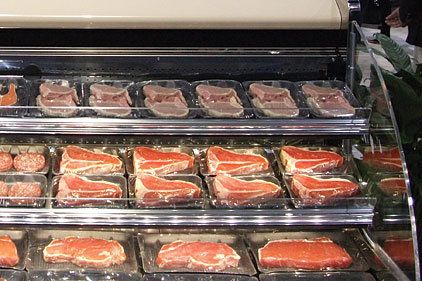It is a regulation targeting large refrigeration facilities such as warehouses and supermarkets that use f-gas refrigerants such as HCFCs and HFCs and does not go after smaller systems as in restaurants or any place that uses ammonia or CO2.
And it could have nationwide implications.
“California has traditionally been the cutting edge of clean air regulations and the efficiency and practicality of this regulation makes it conducive to federal mimicking,” said Dimitri Stanich of the California Air Resources Board (CARB).
The action is called Management of High Global Warming Potential Refrigerants for Stationary Sources, or more simply the Refrigerant Management Program. It took effect in 2011 and relates to “facilities with a refrigeration system that has a refrigerant capacity of more than 50 pounds. [They] must fix leaks within 14 days of detection. These businesses must also keep on site records of all leak-repair work and other servicing of refrigeration systems, including receipts of refrigerant purchases,” according to a statement from CARB.
It is a regulation that reaches directly the refrigeration contractors and service technicians, with the statement that the regulation affects any person “who installs, services, or disposes of any appliance using a high-GWP refrigerant.” And it reaches wholesalers and reclaimers with the reference to those who “sells, distributes and/or reclaims high-GWP refrigerants.”
“This common-sense measure will clamp down and reduce the largest source of highly potent greenhouse gases,” said CARB Chairman Mary D. Nichols. “The rule creates a level playing field by requiring that all businesses use best management practices to monitor and repair refrigerant leaks.”
CARB said, “This rule applies primarily to supermarkets, food and beverage processors, cold storage warehouses, and industrial cooling processes. It does not apply to most bars, restaurants, liquor stores, and office buildings. The rule also does not apply to systems that use ammonia or carbon dioxide as the refrigerant.”
In Development
Further, the statement said, “Development of the regulation took almost two years and included five technical workgroup meetings, seven public workshops, technician and service contractor surveys, and site visits. CARB staff also worked with facility owners, refrigerant manufacturers, and several trade associations to develop the regulation.”
As it is now in effect, the rule requires “leak inspection, repairs, required service practices, and record keeping. Leak inspections will vary from continuous leak monitoring to quarterly or annual leak inspections, depending on the type and size of refrigeration systems.”
There are also additional regulations in future years.
In 2012, about 2,000 facilities with large systems using greater than 2,000 pounds of refrigerant will register, report, and pay an annual fee of $370.
In 2014, about 8,500 facilities with medium systems using between 200 and 2,000 pounds of refrigerant will register, report, and pay an annual fee of $170.
In 2016, about 15,500 facilities with small systems using greater than 50, but less than 200 pounds of refrigerant will submit a one-time registration with no annual fee or reporting.
Fees collected will be used to support outreach, training, enforcement, and administration, it was noted.
Deadlines
As part of the CARB regulations, deadlines were established for owners/operators of systems using 2,000 or more pounds of these refrigerants. By Jan. 1, 2012, automatic leak detection systems must be installed and by March 1 of that year, facility registration, fee payment and annual reporting is due.
“Common refrigerants subject to the rule include, but are not limited to R-12, R-22, R-134a, R-404A, R-407C, R-410A, and R-507.” In addition to reinforcing the fact that systems using ammonia and CO2 are not subject to the rule, CARB noted, “Air conditioners and other systems used exclusively for cooling building occupants do not need to be registered, but are still subject to required service practices.”
Compliance
With almost a year under their belt, how are contractors doing with the aspects of the law that are in effect?
“Many, but not all, comply with U.S. EPA’s Rule 608 adopted in the early 1990s as a result of the Montreal Protocol,” said Stanich. “Many facilities that have comfort cooling systems are relieved to know they are not required to register with the program, but we remind them the rule has Required Service Practices for any size appliance (including a/c only) containing a high-GWP refrigerant. Our rule has some stricter thresholds, such as no venting requirements, leak repair requirements within 14 days (with some exceptions), a lower psi evacuation requirement from cylinders, etc.”
Beyond Stateline
What is the potential for this regulation reaching the national stage? Stanich said, “The Refrigerant Management Program builds on Federal Rule 608 and the Montreal Protocol to reduce ozone depleting substances (ODS) emissions which have high-global warming potential thousands of times greater than carbon dioxide. California’s AB 32 mandates California to reduce greenhouse gases (which include ODS substitutes for which CARB’s rule includes HFCs).
“Until a federal regulation addresses greenhouse gases, the federal rule for ozone-depleting substances only remains in effect. Some states have expressed interest in the (California) Refrigerant Management Program and are watching closely as CARB implements this regulation.”
For more information, visit http://www.arb.ca.gov/cc/reftrack/reftrack.htm.
Publication date: 12/05/2011








